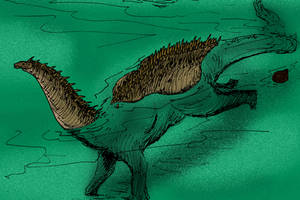Deviation Actions
Description
Day 3: Favourite Silurian Animal
Challenge here (plastospleen.deviantart.com/jo…)
It is time to move to the Silurian epoch, when sea scorpions ruled the oceans, jawed fish began to rise and myriapods started the colonization of land. Maybe the most representative animals of this epoch are the sea scorpions, or eurypterids, a group of arthropods related to horseshoe crabs and arachnids that resembled scorpions. Initially I wanted to depict Brontoscorpio, a true arachnid, but I found nearly nothing about this animal (in fact, it is only known from a pedipalp). Fortunately, there are plenty of creatures to choose from. Eurypterus is known from hundreds of specimens from Europe and North America, and it's anatomy and lifestyle are well known.
Eurypterus was a genus of sea scorpions composed by 14 species (at least) that lived between 432 and 418 mya in the shallow seas of Europe and North America, which were fused at the time in one continent located near the Equator. It's size varied greatly between specimens: The average length of specimens E. remipes is around 20 cm, while the largest individual found was 1.3 m long. It was probably a generalist animal, feeding on small animals and carrion found on the ocean floor and using it's spiky appendages . Two forms of locomotion have been proposed for Eurypterus: while the smaller individuals probably used their paddle-like appendages to swim, like crabs or swimming beetles, larger animals would have moved using a sinuous movement of their body and appendages, like sea lions or sea turtles (a style known as underwater flying).
Eurypterus may have gathered in large groups to breed, like modern horseshoe crabs. The young Eurypterus were morphologically different from their older counterparts, with a different carapace shape and eye location. The respiratory system of this animal has led scientists to believe that it could venture into dry land for short periods of time, maybe to devour some carcasses washed ashore or to breed, like it's modern relatives.
Pterygotus is really close behind, though. It's only 2 decimeters shorter than a person, and it served as the apex predator of the Silurian seas. It's also really neat!

































